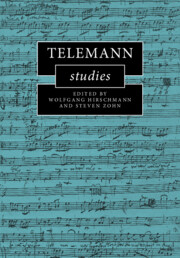Book contents
- Telemann Studies
- Cambridge Composer Studies
- Telemann Studies
- Copyright page
- Contents
- Figures
- Music Examples
- Tables
- Appendices
- Contributors
- Preface
- Abbreviations
- Part I Enlightenment Perspectives
- Part II Urban and Courtly Contexts
- Part III Nature (and) Theology in the Late Vocal Works
- Part IV Bach Family Connections
- Part V Cantata Cycles in Frankfurt, Hamburg, and Beyond
- 13 Recitative Notation in Telemann’s Church Cantatas
- 14 Telemann’s Stolbergischer Jahrgang (1736–1737) in the Context of His Sacred Cantata Cycles
- 15 Telemann’s Cantata Cycle of 1733–1734
- 16 Under the Reign of Telemann’s Sacred Cantata Cycles
- Index of Telemann’s Works
- General Index
16 - Under the Reign of Telemann’s Sacred Cantata Cycles
New Observations on the Music Repertory in Hirschberg, Breslau, and Augsburg
from Part V - Cantata Cycles in Frankfurt, Hamburg, and Beyond
Published online by Cambridge University Press: 14 July 2022
- Telemann Studies
- Cambridge Composer Studies
- Telemann Studies
- Copyright page
- Contents
- Figures
- Music Examples
- Tables
- Appendices
- Contributors
- Preface
- Abbreviations
- Part I Enlightenment Perspectives
- Part II Urban and Courtly Contexts
- Part III Nature (and) Theology in the Late Vocal Works
- Part IV Bach Family Connections
- Part V Cantata Cycles in Frankfurt, Hamburg, and Beyond
- 13 Recitative Notation in Telemann’s Church Cantatas
- 14 Telemann’s Stolbergischer Jahrgang (1736–1737) in the Context of His Sacred Cantata Cycles
- 15 Telemann’s Cantata Cycle of 1733–1734
- 16 Under the Reign of Telemann’s Sacred Cantata Cycles
- Index of Telemann’s Works
- General Index
Summary
New documents reveal an intensive cultivation of Telemann’s church music in some unlikely places during the eighteenth century. Especially striking evidence comes from Breslau, where Gottfried Sauer, cantor at St. Maria Magdalena from 1740 to 1757, compiled an inventory containing no fewer than eight annual cycles of church cantatas by Telemann. From this one may conclude that during Sauer’s tenure at the city’s most important church, fully half of the music he performed was by Telemann. A similarly intensive use of Telemann’s cantata cycles occurred in Augsburg. In both cases, the driving force behind the cultivation of this repertory was a cantor who had contact with Johann Sebastian Bach. Yet despite these personal connections, it was not the church music of the Leipzig Thomaskantor that was performed but the cantata cycles of Telemann – works that were heard again and again. Thus, we may justifiably regard Telemann as the unofficial church music director of Protestant Germany as a whole.
- Type
- Chapter
- Information
- Telemann Studies , pp. 324 - 335Publisher: Cambridge University PressPrint publication year: 2022

